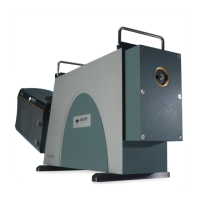32
Version 4.2 rev 06 Oct 2020
8.2 x 8.2 mm / 512 x 512 sensor
Lowest Noise Imaging EMCCD
Mechelle
4.2.1 extraCt SpeCtrum
The ‘extract spectrum from acquisitions’ option must be selected if the user wishes the spectrum to be generated or
updated following every acquisition.
For real-time analysis, ‘extract spectrum in video mode’ or ‘extract spectrum during kinetic series’ should be
enabled. For acquisition rates greater than 10 Hz in kinetic mode, it is recommended to un-select these options as the
spectrum extraction from the image takes ~ 100 ms and can therefore impact the actual acquisition rates. In this case,
after acquisition of the echellogramme images at the desired rate, spectra are then extracted post-acquisition.
4.2.2 Order lineS
The ‘draw order lines on the image’ option superimposes a theoretical echellogramme of the expected orders position
based on current wavelength calibration. It is an extremely useful visual tool to check the system calibration accuracy.
Displaying order number and center wavelength on the image provide also additional useful information during the
calibration process.
NOTE: After the application restarts, the draw order lines on image button
will also be shown on the right side of the
main window toolbar. This button also toggles this option ON and OFF.
The Calibration Temp window indicates the Prism temperature during calibration and the Current Temp window
indicates the actual prism temperature.
4.2.3 temperature and CalibratiOn
The Calibration Temp. eld indicates the prism temperature at time of last calibration and the Current Temp. eld
indicates the actual prism temperature.
Users must select option ‘Image temperature adjustment’ (right hand side) to ensure Echellogramme calibration
accuracy is maintained if prism temperature changes. It is recommended that ‘Save current calibration’ (bottom left) is
selected to ensure new wavelength calibration are permanently saved.
4.2.4 OptiOnS (Other)
The ‘Crosstalk removal order’ feature ensures that potential ghost spectral features generated from a given order into
adjacent orders is removed.
The ‘channel height’ relates to the expected height (in pixels) of the echellogramme orders (up to 5 pixels). The higher
the order, the more signal from the echellogramme will be used to extract the spectrum but with slightly higher chance of
ghost spectral features appearance.
‘Automatic peak nder’ allows spectral features to be labeled with the closest atomic species selected in the periodic
table (see section 4.5.2)

